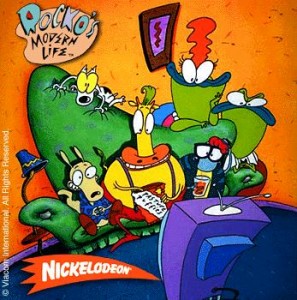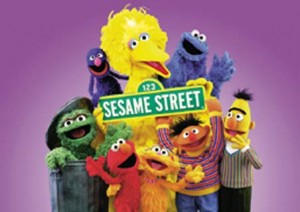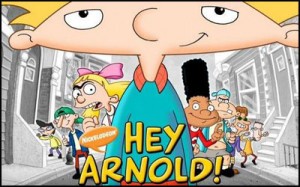Posts Tagged Film
Joe Murray, Betty Boop, and Free-Range Animation
Posted by kjohnson1585 in Film, Television, Uncategorized, Writing on March 12, 2010
I really empathize with Joe Murray.
The creator of Rocko’s Modern Life debuted his titular cartoon on Nickelodeon right as the true face of the internet began to take form; the geekiest among us refer to it as “Eternal September.” While the fresh-faced newcomers to the “World Wide Web” aggressively staked their claim in chat rooms and Usenet boards, Murray was simply content to create a funny, wacky show that pushed boundaries once in a while. The boundary-pushing was merely an afterthought, though; and it took a while before Nickelodeon’s network executives became wise to the game, and seriously curtailed the consistent attempts at crude and gross humor. It’s obvious how the show seemed to calm down its more grotesque elements as the seasons went along: bits with brain removal; board games involving “monkeys” and “whacking paddles;” Heffer, a steer, being milked into what is clearly sexual orgasm – all these seem to disappear towards the latter episodes.
Truth be told, moments like that were far and few in between. But as the show was wrapping up, the INTERNET, with its uncanny love of all things gross, weird, and disturbing, hailed Rocko’s Modern Life as some brilliant takedown of the man and the state of animation as they knew it. It was Invader Zim before Invader Zim was Invader Zim (a cartoon I will be discussing very, very soon).
Don’t get me wrong. Rocko’s Modern Life was definitely a brilliant show, but hardly because of how clever it got away with its shady humor. (FYI, as far as I’m concerned, shady humor is simply humor with a dirty face. I don’t care how much blood, sex, or violence is involved, as long as its funny.) Rocko’s Modern Life was brilliant in its classical embrace and subversion of animation styles and tropes not witnessed since the 1930s, the early days of Betty Boop. Many claim that Ren and Stimpy had a strong influence on Rocko’s Modern Life (like so many modern cartoons), but Max Fleischer’s style has a larger hand in the visual aesthetic and physical gags. That bizarre curvature to Rocko’s world seems to be a callback to the “roundness” and “bounce” of classic black and white animation, and a number of the jokes emphasized that free-range style where objects, literally, come alive – a style that many viewers are disturbed by, mainly because they aren’t quite used to it.
This “free-range” animation should not be confused with Surreal Animation, although they are closely related. Surreal Animation, like the paintings of Dali or the films of Bunuel, emphasize dream-like, or altered states, which, to put it bluntly, pretty much asked its viewers to be high. Free-range animation had no such obligation (although its clear that being high is perfectly acceptable); it simply understood and embraced the full activity of animation, and sought to really ANIMATE the fame, in every possible sense of the word.
Betty Boop is a great example of this. Betty Boop, Max Fleischer’s darling creation in the 1930s, was the masculine epitome of idealized femininity: sweet, innocent, “sexy,” and consistently happy. No matter that the nation was hugely in debt and a global threat loomed over the horizon, Boop’s happy-go-lucky temperament was always intact. The important thing, however, is that Boop did not exist in a world that paralleled our Depression-addled society. Betty’s world was just as happy and free-range as her personality, so much so that it seemed physically designed to curry to her favor. The world would “come alive,” at will, at random, if to assist in helping Boop in anyway it could.
And so, we would see statues and flows anthropomorphize themselves temporarily to console, dance with, or otherwise chat with Boop as she went through her trials and tribulations. She bounced, and the world bounced with her; she cried, and so did everyone else. The animated world of Boop had no limits, and it’s something of a lost art to play so fast and loose with the medium itself.
Rocko’s Modern Life did, albeit in a different fashion. While Boop’s world was idealistically optimistic towards her overall happiness, Rocko’s world was cruel, mean, and crass. One of my favorite gags involved Rocko, while on a skiing trip, choking a bush in anger that was in his way. The trees around him come alive and proceed to attack him in retaliation. But the gag doesn’t end there. When Rocko ends up in the hospital by the end of the episode, the nurse in the lobby directs the same trees to his room (she confuses them for Rocko’s parents). It’s such an amazing gag, and it’s only now that I’ve begun thinking about the joke’s structure.
Rocko’s world was a free expanse of living-at-will objects: trees protecting its own, vacuum cleaners coming alive and eating people, chairs wanting to be sat upon. It’s VERY weird – uncanny even – without a general understand of, or at least exposure to, classic Fleischer animation.
You can see the departure from the free-range to the traditional in Camp Lazlo, a much more streamlined, character-based cartoon. The internet didn’t have its grossed out, surrealist, and/or free-ranged oddness, so it chalked up Camp Lazlo to generic lameness. The humor, however, was still as great as Rocko’s Modern Life was, just more or less regulated to character-based gags than medium-based. Still, I adored Camp Lazlo and truly wished the world did as well.
Most modern cartoons are indeed influenced by Ren and Stimpy, and while that’s to be expected, I have to admit that Murray’s attempt to utilize animation tropes not used since the 30s is rather admirable… and ballsy. Murray has a great sense of comedic time and visual wit, and he uses it excellently, whether he utilizes this free-range animation style or not. Check out a clip from his new, upcoming short.
Why Can’t We Gain “Moral Value” from the Big City?
Posted by kjohnson1585 in Film, Television, Uncategorized, Writing on February 17, 2010
Did You Hear About the Morgans? flopped across all three levels: commercially ($29 million domestic gross vs. a $58 million budget), critically (Metacritic: 27), and socially (Rotten Tomatoes: 13). Of the many things wrong with the film, it seems to be yet another work that espouses the evil, uncaring, cold, urban environment for the beauty, serene, and heartfelt warmth that can only be taken from the most rural of areas. City-folk can’t learn about real values in the hustle and bustle of that big, loud place with the skyscrapers and the traffic and the bums. No: you need to come out here, with the fresh air, the lack of civilization, and little cell phone service, where you’re freed from that boisterous nonsense and given the chance to understand you, your life and your significant other.
“Bullshit,” you say. “Why can’t films take the opposite approach? Why can’t characters move to the city and learn something about life values, movies such as –”
…
Wait. Has there ever even been a movie that done this? Has there been a film or TV show or comic or SOME entertainment medium that allowed the wonder and richness and excitement of the city to spur a character from the negative, overworked, self-centered mindset to the communal, wholesome, respectful one? (Farm-living isn’t exactly a cakewalk.) Can we learn value from the urban landscape? Has there been anyone willing to try?
Off the top of my head, only two films seem to touch partially upon the idea: Manhattan and Lost in Translation. Manhattan I have yet to see, but Woody Allen’s opus to New York is just simply that: it idolizes that specific city. It ignores cities in general, nor does it advocate the kind of generic values that rural areas seem to just impart in spades (see Annie Hall, in which its anti-LA sentiments are pretty glaring). Lost in Translation is closer, but it is not the city of Tokyo and its active culture through which Bill Murray has his transformation. His human revelations are brought about via his time with Scarlett Johansson, and he doesn’t learn about “values” so much as himself. It’s a character study, a fairly good one, but Tokyo, the city, is still inherently a backdrop of excess, noted by the earlier scenes of his longing gazes at the huge towers and bright lights. He didn’t go to Tokyo and, by extension, learn wholesome, gosh-darn-it lessons.
It’s easy to see why this trope-bordering-on-cliche is so prevalent in films today. From a technical and visual level, the city imparts a sense of lack of control, a frustrating milieu of frantic action that can’t adequately define or reflect the feeling of love, family, community, or friendship. What is the value of a kiss or a hug or a handshake, when horns and siren blare incessantly in background, across stone-cold swaths of grays? Any potential meaning there is rendered moot.
Surburbia used to be a breeding ground for such moral considerations, but since then, the 50s have been exposed as a hotbed of barely-hidden racism and sexism (see Mad Men), and dysfunction within the suburban family has been overly represented in films like Ed Wood, American Beauty, and The Weather Man. We could return to that locale to exercise clean and ethical living, but it would appear more like pastiche then genuine representation (see Blue Velvet).
This leaves rural America, with its wide open spaces and natural beauty, to be the venue in which such virtuous sensations arise. And while films have been produced that showcases the negative of expanse and freedom (Sling Blade, practically every horror movie ever), comedies, dramas, and even “dramedies” often pull their characters to these country scenarios to meditate on their state of mind, only to emerge a changed man or woman.
It would take a brave and visionary filmmaker to pool the right types of talents together to make a movie where the urban environment could be as rich and rewarding a place as a rural one. But it would be hard to do so. And expensive.
In retrospect, I can only think of two forms of entertainment that seem to suggest that the sprawling metropolis and the underlying streets have value, not only in the rich expanses of awe-inspiring architecture, but even in the meager conditions of street life, an area so often depicted with grim and filth, gangs and pimps, drugs and danger.
Oddly enough, they are children shows.
Sesame Street’s main formula — mildly straightforward and simple stories mixed with cartoons, skits, and segues about letters and numbers — has an underlying richness within itself, with characters that do indeed live and care and are generally helpful to each other. These are attitudes that are so often depicted in close-knit rural towns, where everyone knows everyone, so it’s great to finally see it in an area that could be Brooklyn or South Central LA. In my experience, the city is a lot more receptive to newcomers than the rural areas. The city is a constant hotbed of people coming and going, where strangers are a daily occurrence. Rural areas, while not outright distrustful, seem so keen on conforming the newcomer to their way of life — which of course, is undeniably right — than generally accepting the strangers’ ways of doing things. Just watch how Sesame Street deals with new puppets or locals. The introduction of Linda Bove, who brought the issue of deafness and sign language to the show, hosts ten times the significance than any camera shot of a quiet brook among trees.
Hey Arnold came, had a good run, and went; I personally think we missed a real opportunity by not adequately discussing the value of the urban youth this show quite accurately presented. While the main character, Arnold, was rather smaltzy for any child to be, the overall feel for the show was endearing. These were not the bratty, annoyingly precocious children that so often grace our Sleepless in Seattle’s and Jerry Maguire’s. These were real kids with real emotion issues, who struggled in schools named by number only, who played stickball and fooled around in the mud, who learned about themselves and their lot, not by escaping the urban landscape but by embracing it. When a character takes a city bus – public transportation! – and learns about the value of the people around her, that’s something real.
Neither of these shows contained a character from the country moving to the city and gaining a wholesome rebirth of the spirit (although I do think an episode of Hey Arnold did cover that). But what this does showcase is that places like New York, Los Angeles, Cleveland, Dallas, and, yes, even Detroit, can be rich with those moral instructions on life, love, and community that seem only regulated to areas that pits five miles of land between neighbors.
I don’t mean to harp on the rural communities, but films really need to start embracing the urban sprawl as containing those “values” that seem natural to rural or the occasional suburban world. Surely we can’t allow for PBS and Nickelodeon to be the only place that allow for such a viewpoint, one that uses the light-hearted, socially-interpreted media of puppetry and animation to appeal to kids, focusing on the values less as an artistic and narrative endeavor and more of a method to “educate” children. I would like the Jacksons, Roths, Tarantinos, Reitmans, and the many other directors, writers, and producers to look at the hustle and bustle of the asphalt jungle and, perhaps, find its own flow, its own community, its own wonder that can be passed along to audiences.
My Writing Quest: Part 1 of a Billion
Posted by kjohnson1585 in Film, Video Games, Writing on January 6, 2010
I will start providing more information concerning my developing writing career. The HORROR.
I recently began a much-stronger push to develop my writing. I guess you could call it my 2010 Resolution, although I resolved to do it pretty much last summer when I started this blog. I got a few fun gigs – I write this one, I write for Destructoid’s Community Blogs, and I’ve been pegged to write for a brand new video game site, Damnlag. (It’s still being coded, so it’s not quite ready yet.) I am also doing reviews for Wildsound Filmmaking, an atrociously designed website that, at the very least, allows me to watch some classic horror films (and pays). Some rock (The Fly), some do not (The Black Scorpion). I’m putting together a portfolio and even made some business cards.
Also, screenplays are in the works. I suppose I should tell you what I have: technically, I have three full-length features “done”. Two I had to do in college (and I probably won’t touch them ever again), and one I recently did for Coverage Ink (more on that in a second). I also have written two full-length fan-scripts based on some video game properties. Why? Two reasons: one, I wanted to test my abilities at adaptations, and even though they won’t sell, it still pushes my skillset as a writer. Two, I wanted to see if it was really that hard and complex to scribe a decent screenplay from a game. (Conclusion: It is, but it helps being a fan of the game as well as understanding the nuances of storytelling. Also, taking the time to think about it.) That’s 5 nearly-120 pages scripts. Huh.
In addition, I wrote six episodes of an animated sitcom. Now, animated shows aren’t usually written so much as the ideas are tossed around until they’re defined enough for storyboarding. But some sources seem to suggest that the teleplay for cartoons are becoming more and more necessary. Given that this show is more attuned to Futurama (I’m actually pitching it as Johnny Bravo meets Futurama), it’s more about character-humor than the other types, although I do use a number of physical, timing, word, and cutaway gags. I wanna commission some concept art soon.
(An aside: one of my biggest revelations was how much I adore the animated/video game-y stories, with huge, creative worlds, wacky characters, and practically limitless borders. Once I got away from ideas of people doing stuff that people do, it really improved my drive and makes writing what it should always be: fun. I’d love to be able to write something with the heart of a Pixar film, but if only make it to the level of a high-valued Dreamworks film, hell, I’d take it. THIS site really solidified my drive.)
As for Coverage Ink: in the summer, I entered a contest called the CSOpen, a three-week adventure where you had to write 5-page scenes based on premises that were provided for you. The trick was, each round had a shortened time-frame. I made it to the final round, but failed to put together a decent submission with the required 3 hours. Yet, my second submission was really good, and I ended up pushing it out into a full length. Coverage Ink, the sponsor of the CSOpen, offered coverage service at a discount, so I went ahead and submitted it, JUST to see where it and I stack against the competition. I have a bit of faith in how it turned out, but I have to expect a PASS just to maintain some realism. I’ll know the results this weekend. I’m nervous as hell.
We will see. I’ll be heading out to LA for a week, getting a taste of the town and perhaps a bit of networking? We’ll see what happens.






